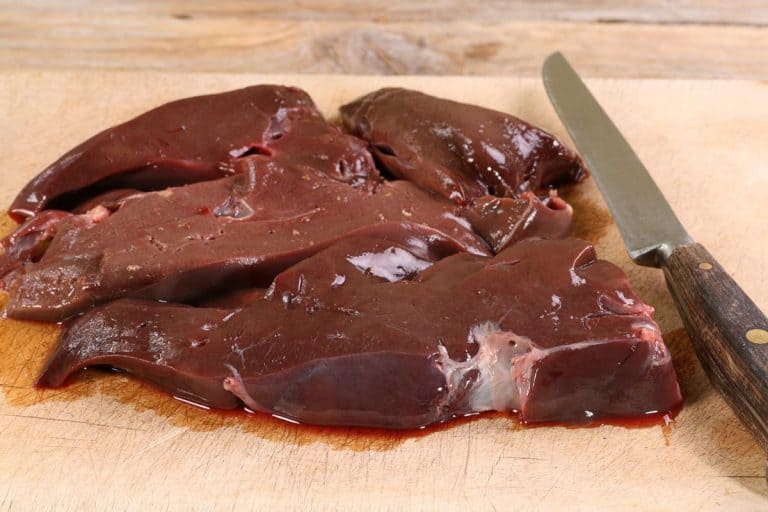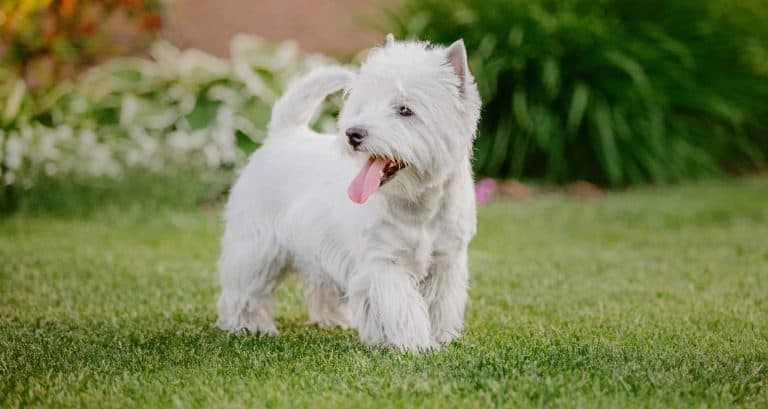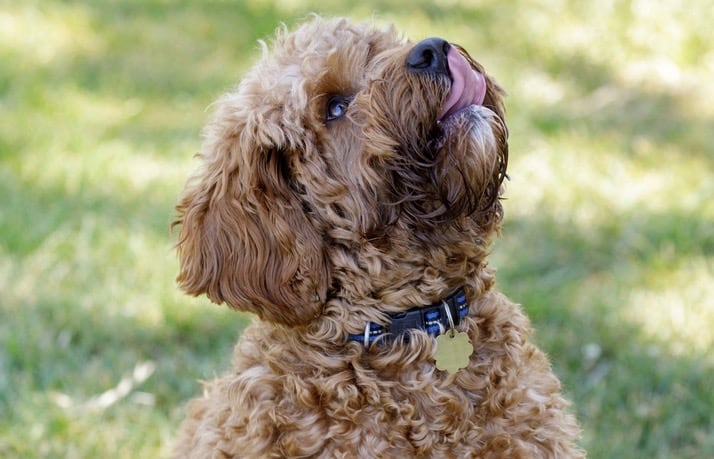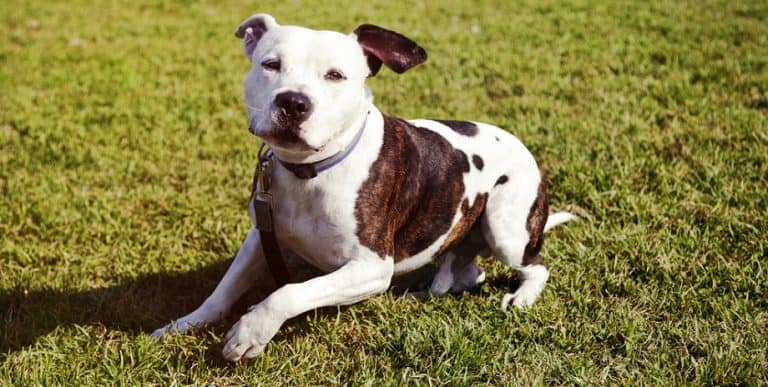Blue Heeler Growth Chart – Australian Cattle Dog Weight & Size Chart
Australian Cattle dogs are also referred to as Blue Heelers. They are energetic and obedient working dogs with a unique, blue or red color speckling.
If you are considering getting an Australian Cattle Dog, then you may be wondering just how big this breed will get.
If so, then this article which contains a Blue Heeler growth chart will definitely be of help.
Bred by Australian settlers to handle herds of cattle on large ranches, they are a sturdy dog breed, but they are also very intelligent.
They are still utilized today as herding dogs, and they enjoy having a job to do and being included in family activities.
Australian Cattle dogs are known to be hardworking. They will be at their best if they have a worthwhile task to complete, and when they are able to maintain a busy lifestyle.
When Do Blue Heelers Growing?
As a medium dog breed, Blue Heelers are seen as full-grown when they are around 18 to 24 months of age.
Their final height tends to be reached between 9 and 11 months even though their growth plates have finished healing between 11 and 12 months of age
However, it is not until they are between 18 and 24 months of age they often do not reach their full weight.
The reason why they are only considered grown after they have reached their target height is because of the additional time it takes for them to put on their weight.
When it comes to weight, there is a difference between males and females, with males being slightly bigger.
The average female Australian Cattle Dog has a weight of between 30-35 lbs. (14-16 kg) and a height of between 17-18″ (45-48 cm) at the shoulder.
The average male Australian Cattle Dog has a weight of between 35-50 lbs (14-22 kg) and stands at 18-20″ (46-51 cm) at the shoulder.
Blue Heeler Growth Chart

The following Australian Cattle Dog growth chart gives a typical range for the size of your Australian Cattle Dog by weight.
Anyone viewing the Blue Heeler size chart should understand that the figure ranges are meant to be a general guide for what is normally seen for the Australian Cattle Dog breed.
It is simply a frame of reference so that you can monitor your dog’s development.
It is also useful for planning his future as you may need to arrange his accommodation and other necessary requirements for a happy healthy dog.
Because the figures are an approximation, the weight ranges mentioned may be a bit lower or higher than what is actually true for your dog.
As the dog owner, you may be the best person to determine whether there is a serious problem. Australian Cattle dogs sometimes grow to 55 pounds and still are in good health.
It is not uncommon for dogs to gain a bit of weight, especially if they don’t get proper exercise or are overeating. If you are unsure about anything, please speak with your vet.
Australian Cattle Dog Weight Chart
| Age | Weight Range (lb) | Weight Range (kg) |
|---|---|---|
| 3 Months | 12 - 15 lb | 5.5 - 6.8 kg |
| 4 Months | 15 - 18 lb | 6.8 - 8.1 kg |
| 5 Months | 20 - 24 lb | 9 - 10.8 kg |
| 6 Months | 23 - 26 lb | 10.5 - 11.8 kg |
| 7 Months | 25 - 29 lb | 11.3 - 13.1 kg |
| 8 Months | 26 - 30 lb | 11.8 - 13.6 kg |
| 9 Months | 27 - 31 lb | 12.2 - 14 kg |
| 10 Months | 28 - 33 lb | 12.7 - 15 kg |
| 11 Months | 29 - 34 lb | 13.1 - 15.4 kg |
| 12 Months | 30 - 35 lb | 13.6 - 15.9 kg |
| 16 Months | 31 - 45 lb | 14 - 20.5 kg |
Australian Cattle Dog Growth – What To Expect

Birth – 2 Weeks
Australian Cattle Dogs enter the world, in a sensitive state as they can’t care for themselves. Their mother will feed them and give them warmth.
They are unable to see or hear as those senses are not available to them as yet. They are basically seeking warmth and nourishment from their mom so that they can develop their strength. Expect a lot of sleeping.
3 Weeks – 12 Weeks
At this stage, your Australian Cattle Dog begins to have stronger muscles. Many people enjoy this time the most because the puppies are cute and playful.
They will be exploring their surroundings and learning to empty their bowels and bladder. They will be involved in all types of mischief with their siblings.
4 Months – 6 Months
Your Australian Cattle Dogs start gaining height and muscle as they rapidly grow at this time. They look to their owner less and begin to explore.
After this stage has passed, training will become considerably more difficult. You need to establish yourself as the main authority in his life and ensure that he is being trained properly.
7 Months – 9 Months
Your Australian Cattle Dogs will show their first signs of puberty. Male dogs will now be able to produce viable sperm while the females would be expected to experience a heat cycle for the first time.
Ensure that they are monitored closely during this period as they have the tendency to stray in pursuit of mating partners.
10 Months – 12 Month
Because of the introduction of sexual hormones into your dog’s body, the growth rate will be affected. This is especially true for male dogs.
You may notice that your Australian Cattle Dog experiences a disruption in growth.
This has to do with the hormones and whether or not they are spayed or neutered. Blue Heelers are a medium dog breed so after 9 months or so, there will be a slower pace of growth.
Adult
There is some variation in the way dogs develop and mature. The puppy development stages and ages outlined above are a rough guide.
A full-grown Australian Cattle Dogs is usually compact and muscular, with a well-balanced physique.
Many dogs will continue to grow and gain muscle until they are two years old. When it comes to training your Australian Cattle Dog, you get out what you put in.
Blue Heeler Size Chart (Length & Height)
Australian Cattle Dogs usually weigh around 31-35 lb (14-16 kg). On average, Australian Cattle Dogs have a body length of 28.0”-33.0” (71-84 cm), withers height of 17.0″-20.0” (43-51 cm), and an overall height of 21.0”-25.0” (53-64 cm).
The Australian Cattle Dog is a solid, hard-muscled herder of strength and agility standing between 17 to 20 inches at the shoulder.
Australian Cattle Dogs are born with white coats that turn red or blue-gray. Distinctive mottling or specking patterns are characteristic of both coat varieties.
Australian Cattle Dogs usually achieve their full height sooner than they will attain their maximum weight. Additionally, most Heelers are their tallest when they are somewhere between 9 and 11 months old.
How Big Will My Blue Heeler Puppy Get?

Many potential owners are interested in knowing how big Blue Heelers will get. On average, male Heelers will weigh between 37 and 45 pounds and stand about 19 in tall, in adulthood.
Also, most female Australian Cattle Dogs will weigh between 32 and 40 pounds and will mature out at around 18 inches at the top of the shoulders.
On the other hand, until as late as 18 to 24 months old, Heelers sometimes do not achieve their full maximum weight. There are a few variations, within the breed when it comes to body and frame type.
Dog parents typically use the current weight and age of their Australian Cattle Dogs and extrapolate based on average data of the breed.
This is why looking at a Blue Heeler growth chart is so helpful.
Do Blue Heelers Still Grow After Being Neutered & Spayed?
Neutering involves the removal of testicles in male dogs to prevent them from reproducing while spaying removes the ovaries and uterus preventing the female dogs from becoming pregnant.
These procedures do not affect the growth of your Blue Heeler when done at the right time, preferably between the ages of five and nine months.
However, you should speak to your vet about this to know exactly when to do these procedures.
There are benefits of spaying and neutering including reducing aggressive behavior, minimizing the risk of testicular cancer in males, and preventing ovarian cancer in females.
How Big Is a Blue Heeler Puppy When He Is Born?

A Blue Heeler puppy weighs between 7 to 11 pounds as a newborn. At this stage, the puppy is fully dependent on the mother for nutrition, cleaning, warmth, and elimination.
The puppy’s eyes and ears are not yet open, therefore, they cannot see or hear, so they spend most of their time sleeping.
How Big Should A 6-Month-Old Blue Heeler Be?
The weight of a Blue Heeler at 6 months is between 23 and 26 pounds. Your dog will still be growing in height and adding more weight.
This is the stage where your dog reaches sexual maturity making it the right time to spay or neuter them.
Speak to your vet about this. You should also continue socializing and training them at this age as they have lots of energy.
Is Blue Heeler a Medium or Large Dog Breed?
Blue Heeler is categorized as a medium-sized breed dog with a compact and muscular build. Even though they are not too big, their body is super fit which gives them extra endurance and strength.
Their adult weight is about 35 to 50 pounds with a height of about 17 and 20 inches. However, some might be slightly smaller or bigger compared to the breed average size.
What Is a Blue Heeler’s Neck Size?
Finding the neck measurements for your Blue Heeler will enable you to buy them the right collar that fits them perfectly and is not too tight or too loose. You can use a phone charger cable to determine the measurements.
Hold one end of the cable between your thumb and finger then use the other hand to wrap the cable around the thickest part of your dog’s neck.
Slide two fingers between the neck and the cable to ensure that it is not tight.
Let go of the cable end and then mark a spot on the cable where the wrap ends. Use a measuring tape to take measurements of the charger end to the mark, and this is your dog’s neck size.
On average, the neck size of Blue Heelers is between 22 and 28 inches.
Blue Heeler Body Condition Score (BCS)
Body Condition Score (BCS) is a method used to evaluate the body fat of animals. There are two BCS scales: one ranging from 1 to 9 and the other from 1 to 5.
If your dog has a BCS score of 5/5 or 9/9, they are obese and need to lose weight to be healthy. If the score is 1/9 or 1/5, your dog is emaciated and needs to gain weight to have proper functioning and development.
Therefore, the ideal BCS score for your Blue Heeler should be 3/5 or 5/9. This is when you can feel the ribs through a thin layer of fat and the abdominal tuck and waistline is visible.
How To Help Your Blue Heeler Lose Weight If He Is Overweight
If the weight of your Blue Heeler is more than their ideal weight for their age category, you should help them lose the weight.
First, take them to the vet for diagnosis to eliminate any health conditions that may be causing the weight gain.
There are different ways that you can help your Blue Heeler lose weight including the following:
- Keep them active by increasing the amount of exercise so that they can burn more calories. Regular walks and play in the park or backyard can go a long way in reducing their weight.
- Reduce table scraps and treat them as they can add unnecessary calories making them gain weight.
- Measure and monitor the amount of food you are feeding them. Ensure that the food is balanced and healthy.
Factors That Affect Australian Cattle Dog Growth
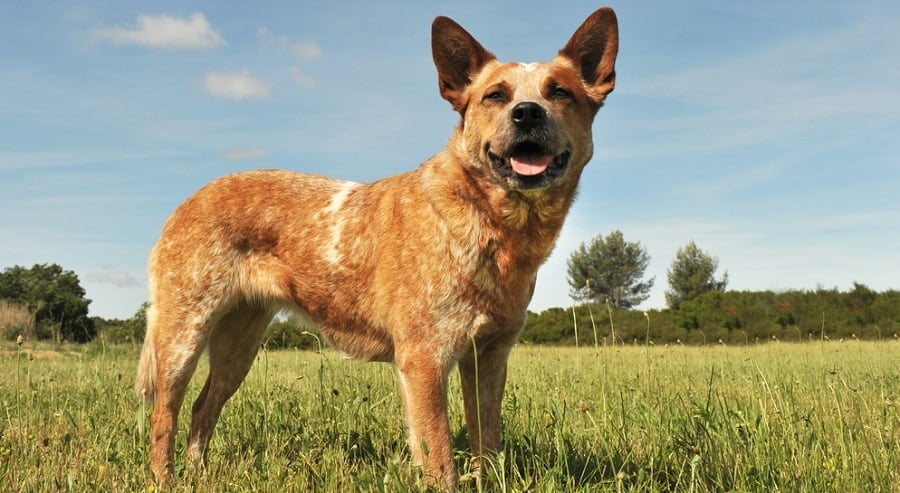
Genetics
Just as humans are impacted by genetics, it is the same with dogs because they also have genes inherited from their parents and generations before them.
These genes regulate growth rates and propensity to certain diseases. These biological factors control the development of your Australian Cattle dog puppy.
Nutrition
Proper nutrition in a dog is directly related to the development of your Australian Cattle dog puppy. When your dog consumes food, he is either aiding his growth and development or stunting it.
This why it is so important to feed him the best food you can put your hands on.
Foods of a low quality also have the potential to get him sick. The money that many owners believe that they will be saving on foods is almost always spent on health after a while.
This is because it is impossible for your puppy to thrive on bad food.
Physical Activity & Health
Blue Heelers need ample exercise because they are an active breed. There are countless benefits to physical activity.
A major reason that your dog needs exercise as he grows is that it allows the proper development of bone density. He will also have strong and healthy muscles due to exercise.
Above all, an Australian Cattle Dog is always in high spirits when they are allowed to participate in physical activity.
This will redirect his energy away from destructive behaviors around the house. He will also enjoy the quality time he gets to spend with you.
What If My Australian Cattle Dog Is Not The Right Weight
If you are a responsible dog parent, you may be concerned about your Australian Cattle Dog meeting developmental milestones.
Therefore you would like to know if he is currently the right weight and estimates his weight in the future.
The first thing you need to know is that all dogs develop at different rates. This even goes for dogs that are within the same dog breed.
There are a variety of factors that can determine the weight of your Blue Heeler.
Consult the Blue Heeler weight chart to see if your pup falls within the correct weight range. If he doesn’t, you should monitor his health and talk to your veterinarian if you have noticed anything serious or if you are unsure about anything.
What Is The Life Expectancy Of Australian Cattle Dogs?
The typical lifespan of an Australian Cattle dog is around 12 to 15 years. They usually suffer a natural death when they are around 13 and a half years of age.
This is not surprising because Blue Heelers are medium-sized dogs and dog breeds that a smaller in size, tend to have longer life spans.
That said, there are ways that dog parents can prolong the life of their dogs.
It goes without saying that proper diet, exercise, and prevention of diseases that are prevalent within the breed will do a long way in extending the lifespan.
How Much Does It Cost To Own An Australian Cattle Dog?
If you want to own an Australian Cattle dog, it will cost you around$1000 to $2500 annually. The basic needs like vet visits, food, toys, training, and vaccinations will be handled with this amount.
This comes as great news for dog owners who can spend less because the Blue Heeler is medium-sized. A larger dog would be more costly.
This is especially so for dog breeds with thick long fur.
You need to think about the food you will be giving your Australian Cattle dog. It is not recommended that you attempt to cut corners when it comes to feeding your dog.
Australian Cattle Dog Genetics And Common Health Problems
Many Australian Cattle Dog diseases and health conditions are due to his biology or genetics. This means that they are associated with your pet’s breed.
There are certain conditions that have a significant rate of incidence in Australian Cattle Dogs. This only means that your dog has a higher likelihood than other dogs. It does not necessarily mean that your dog will have these problems.
A few of the major health concerns suffered by the Australian Cattle Dog are progressive retinal atrophy (PRA), elbow dysplasia, deafness, canine hip dysplasia (CHD), and Osteochondrosis Dissecans (OCD).
Other than these conditions, some of the conditions that can be sometimes seen in the Australian Cattle Dog are lens luxation, cataract, and Persistent Pupillary Membrane (PPM).
This is why you should have regular tests done on his hips, elbows, eyes, and ears.
An Australian Cattle Dog’s teeth should be brushed regularly, and his ears should be checked regularly to remove foreign matter and avoid a buildup of wax.
Final Words
This medium-sized dog breed needs to be kept busy and is very energetic. Many owners of Australian Cattle Dogs frequently report that their dogs are just not content sitting around the house.
This is why it is recommended that their owners take them outside for exercise, play or even work.
Raising a Blue Heeler from a puppy will take commitment from the dog owner, and if you have previous experience with dogs it will help you.
You should be careful with an Australian Cattle Dog, particularly if you have young children that are active.
Because they are not very large dogs once fully mature, Australian Cattle Dogs do not take very long to attain their expected weight and height.


